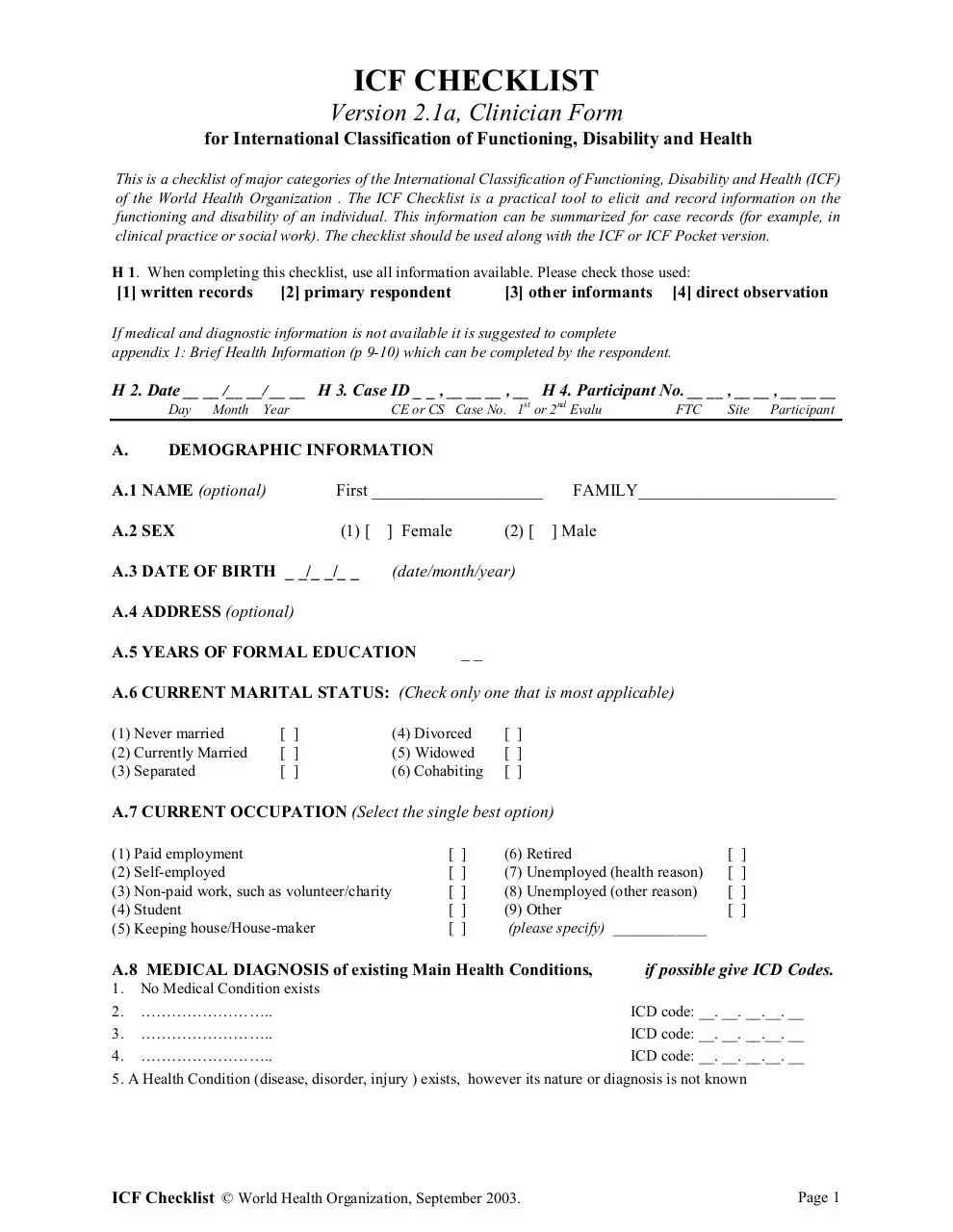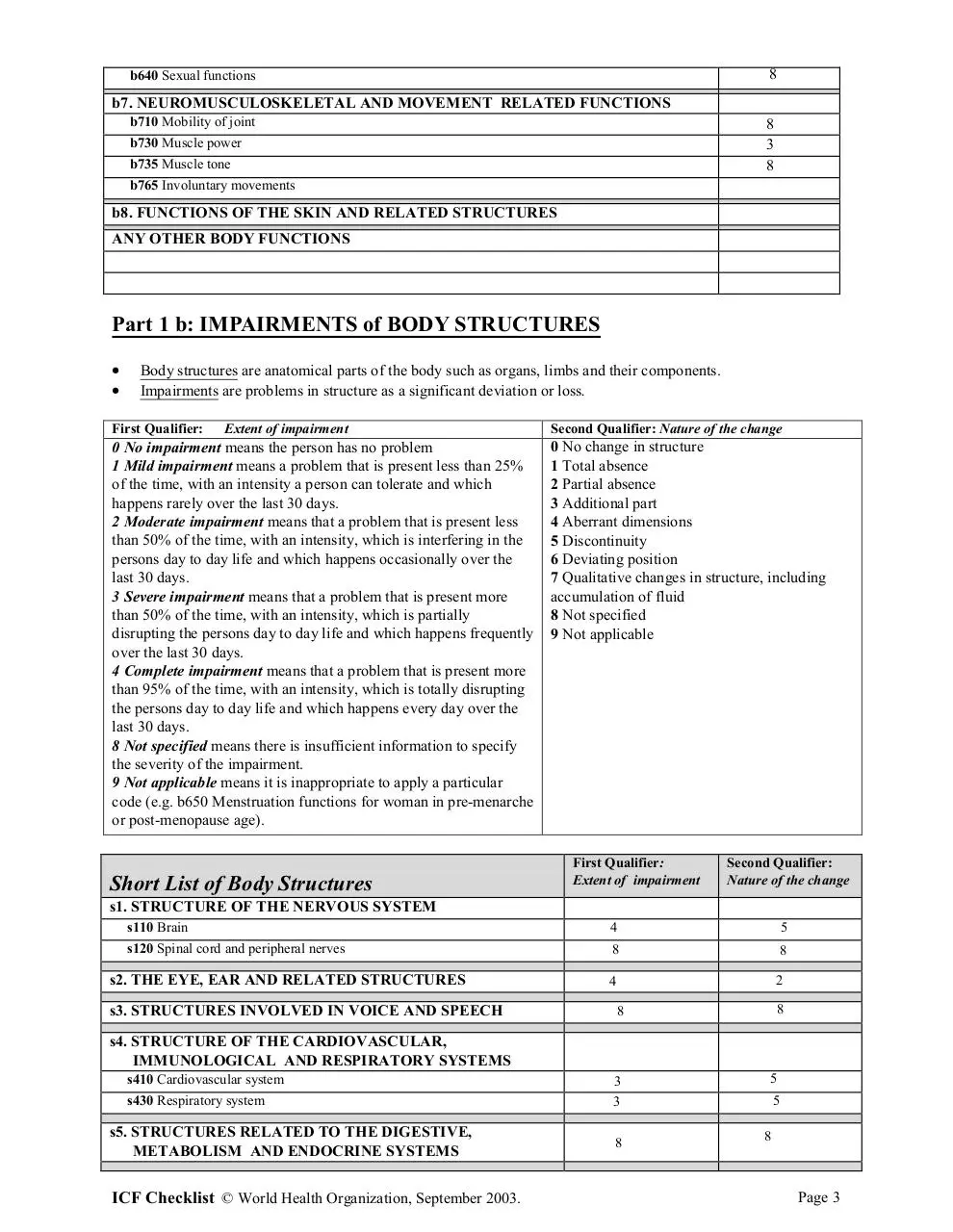icfchecklist (PDF)
File information
Title: ICF Checklist revSep2003
Author: Nenad Kostanjsek
This PDF 1.6 document has been generated by Microsoft Word 8.0 / Acrobat Distiller 4.05 for Windows, and has been sent on pdf-archive.com on 01/05/2016 at 05:57, from IP address 67.176.x.x.
The current document download page has been viewed 1619 times.
File size: 250.49 KB (15 pages).
Privacy: public file





File preview
ICF CHECKLIST
Version 2.1a, Clinician Form
for International Classification of Functioning, Disability and Health
This is a checklist of major categories of the International Classification of Functioning, Disability and Health (ICF)
of the World Health Organization . The ICF Checklist is a practical tool to elicit and record information on the
functioning and disability of an individual. This information can be summarized for case records (for example, in
clinical practice or social work). The checklist should be used along with the ICF or ICF Pocket version.
H 1. When completing this checklist, use all information available. Please check those used:
[1] written records
[2] primary respondent
[3] other informants
[4] direct observation
If medical and diagnostic information is not available it is suggested to complete
appendix 1: Brief Health Information (p 9-10) which can be completed by the respondent.
H 2. Date __ __ /__ __/ __ __ H 3. Case ID _ _ , __ __ __ , __ H 4. Participant No. __ __ , __ __ , __ __ __
Day
A.
Month
CE or CS Case No. 1st or 2nd Evalu
Year
FTC
Site
Participant
DEMOGRAPHIC INFORMATION
A.1 NAME (optional)
First ____________________
A.2 SEX
(1) [
(2) [
] Female
A.3 DATE OF BIRTH _ _/_ _/_ _
FAMILY_______________________
] Male
(date/month/year)
A.4 ADDRESS (optional)
A.5 YEARS OF FORMAL EDUCATION
__
A.6 CURRENT MARITAL STATUS: (Check only one that is most applicable)
(1) Never married
(2) Currently Married
(3) Separated
[ ]
[ ]
[ ]
(4) Divorced
(5) Widowed
(6) Cohabiting
[ ]
[ ]
[ ]
A.7 CURRENT OCCUPATION (Select the single best option)
(1) Paid employment
(2) Self-employed
(3) Non-paid work, such as volunteer/charity
(4) Student
(5) Keeping house/House-maker
[
[
[
[
[
]
]
]
]
]
(6) Retired
(7) Unemployed (health reason)
(8) Unemployed (other reason)
(9) Other
(please specify) ____________
A.8 MEDICAL DIAGNOSIS of existing Main Health Conditions,
[
[
[
[
]
]
]
]
if possible give ICD Codes.
1. No Medical Condition exists
2. ……………………..
ICD code: __. __. __.__. __
3. ……………………..
ICD code: __. __. __.__. __
4. ……………………..
ICD code: __. __. __.__. __
5. A Health Condition (disease, disorder, injury ) exists, however its nature or diagnosis is not known
ICF Checklist © World Health Organization, September 2003.
Page 1
PART 1a: IMPAIRMENTS of BODY FUNCTIONS
•
•
Body functions are the physiological functions of body systems (including psychological functions).
Impairments are problems in body function as a significant deviation or loss.
First Qualifier: Extent of impairments
0 No impairment means the person has no problem
1 Mild impairment means a problem that is present less than 25% of the time, with an intensity a person can tolerate
and which happens rarely over the last 30 days.
2 Moderate impairment means that a problem that is present less than 50% of the time, with an intensity, which is
interfering in the persons day to day life and which happens occasionally over the last 30 days.
3 Severe impairment means that a problem that is present more than 50% of the time, with an intensity, which is
partially disrupting the persons day to day life and which happens frequently over the last 30 days.
4 Complete impairment means that a problem that is present more than 95% of the time, with an intensity, which is
totally disrupting the persons day to day life and which happens every day over the last 30 days.
8 Not specified means there is insufficient information to specify the severity of the impairment.
9 Not applicable means it is inappropriate to apply a particular code (e.g. b650 Menstruation functions for woman in
pre-menarche or post-menopause age).
Short List of Body Functions
Qualifier
b1. MENTAL FUNCTIONS
8
3
3
8
3
b110 Consciousness
b114 Orientation
b117 Intellectual
(time, place, person)
( incl. Retardation, dementia)
b130 Energy and drive functions
b134 Sleep
b140 Attention
b144 Memory
b152 Emotional functions
b156 Perceptual functions
b164 Higher level cognitive functions
b167 Language
2
2
8
8
8
8
b2. SENSORY FUNCTIONS AND PAIN
b210 Seeing
b230 Hearing
b235 Vestibular (incl. Balance functions)
b280 Pain
4
8
8
3
b3. VOICE AND SPEECH FUNCTIONS
b310 Voice
8
b4. FUNCTIONS OF THE CARDIOVASCULAR, HAEMATOLOGICAL,
IMMUNOLOGICAL AND RESPIRATORY SYSTEMS
b410 Heart
3
b420 Blood pressure
4
8
8
3
b430 Haematological (blood)
b435 Immunological (allergies, hypersensitivity)
b440 Respiration (breathing)
b5. FUNCTIONS OF THE DIGESTIVE, METABOLIC AND ENDOCRINE SYSTEMS
b530 Weight maintenance
8
4
2
b555 Endocrine glands (hormonal changes)
8
b515 Digestive
b525 Defecation
b6. GENITOURINARY AND REPRODUCTIVE FUNCTIONS
b620 Urination functions
4
8
b640 Sexual functions
b7. NEUROMUSCULOSKELETAL AND MOVEMENT RELATED FUNCTIONS
8
3
8
b710 Mobility of joint
b730 Muscle power
b735 Muscle tone
b765 Involuntary movements
b8. FUNCTIONS OF THE SKIN AND RELATED STRUCTURES
ANY OTHER BODY FUNCTIONS
Part 1 b: IMPAIRMENTS of BODY STRUCTURES
•
•
Body structures are anatomical parts of the body such as organs, limbs and their components.
Impairments are problems in structure as a significant deviation or loss.
First Qualifier:
Extent of impairment
0 No impairment means the person has no problem
1 Mild impairment means a problem that is present less than 25%
of the time, with an intensity a person can tolerate and which
happens rarely over the last 30 days.
2 Moderate impairment means that a problem that is present less
than 50% of the time, with an intensity, which is interfering in the
persons day to day life and which happens occasionally over the
last 30 days.
3 Severe impairment means that a problem that is present more
than 50% of the time, with an intensity, which is partially
disrupting the persons day to day life and which happens frequently
over the last 30 days.
4 Complete impairment means that a problem that is present more
than 95% of the time, with an intensity, which is totally disrupting
the persons day to day life and which happens every day over the
last 30 days.
8 Not specified means there is insufficient information to specify
the severity of the impairment.
9 Not applicable means it is inappropriate to apply a particular
code (e.g. b650 Menstruation functions for woman in pre-menarche
or post-menopause age).
Short List of Body Structures
Second Qualifier: Nature of the change
0 No change in structure
1 Total absence
2 Partial absence
3 Additional part
4 Aberrant dimensions
5 Discontinuity
6 Deviating position
7 Qualitative changes in structure, including
accumulation of fluid
8 Not specified
9 Not applicable
First Qualifier:
Extent of impairment
Second Qualifier:
Nature of the change
s1. STRUCTURE OF THE NERVOUS SYSTEM
s110 Brain
4
5
s120 Spinal cord and peripheral nerves
8
8
s2. THE EYE, EAR AND RELATED STRUCTURES
s3. STRUCTURES INVOLVED IN VOICE AND SPEECH
2
4
s4. STRUCTURE OF THE CARDIOVASCULAR,
IMMUNOLOGICAL AND RESPIRATORY SYSTEMS
s410 Cardiovascular system
s430 Respiratory system
s5. STRUCTURES RELATED TO THE DIGESTIVE,
METABOLISM AND ENDOCRINE SYSTEMS
ICF Checklist © World Health Organization, September 2003.
8
8
3
3
8
5
5
8
Page 3
s6. STRUCTURE RELATED TO GENITOURINARY AND
REPRODUCTIVE SYSTEM
s610 Urinary system
s630 Reproductive system
4
4
5
5
s7. STRUCTURE RELATED TO MOVEMENT
s710 Head and neck region
s720 Shoulder region
s730 Upper extremity (arm, hand)
s740 Pelvis
s750 Lower extremity (leg, foot)
s760 Trunk
s8. SKIN AND RELATED STRUCTURES
0
0
3
8
4
0
8
8
8
5
8
2
8
8
ANY OTHER BODY STRUCTURES
PART 2: ACTIVITY LIMITATIONS & PARTICIPATION RESTRICTION
•
•
Activity is the execution of a task or action by an individual.. Participation is involvement in a life situation.
Activity limitations are difficulties an individual may have in executing activities. Participation restrictions are
problems an individual may have in involvement in life situations.
The Performance qualifier indicates the extent of Participation restriction by describing the persons actual
performance of a task or action in his or her current environment. Because the current environment brings in the
societal context, performance can also be understood as "involvement in a life situation" or "the lived experience"
of people in the actual context in which they live. This context includes the environmental factors – all aspects of the
physical, social and attitudinal world that can be coded using the Environmental. The Performance qualifier
measures the difficulty the respondent experiences in doing things, assuming that they want to do them.
The Capacity qualifier indicates the extent of Activity limitation by describing the person ability to execute a task
or an action. The Capacity qualifier focuses on limitations that are inherent or intrinsic features of the person
themselves. These limitations should be direct manifestations of the respondent's health state, without the
assistance. By assistance we mean the help of another person, or assistance provided by an adapted or specially
designed tool or vehicle, or any form of environmental modification to a room, home, workplace etc.. The level of
capacity should be judged relative to that normally expected of the person, or the person's capacity before they
acquired their health condition.
Note: Use Appendix 2 if needed to elicit information on the Activities and Participation of the individual
First Qualifier: Performance
Extent of Participation Restriction
Second Qualifier: Capacity (without assistance)
Extent of Activity limitation
0 No difficulty means the person has no problem
1 Mild difficulty means a problem that is present less than 25% of the time, with an intensity a person can tolerate
and which happens rarely over the last 30 days.
2 Moderate difficulty means that a problem that is present less than 50% of the time, with an intensity, which is
interfering in the persons day to day life and which happens occasionally over the last 30 days.
3 Severe difficulty means that a problem that is present more than 50% of the time, with an intensity, which is
partially disrupting the persons day to day life and which happens frequently over the last 30 days.
4 Complete difficulty means that a problem that is present more than 95% of the time, with an intensity, which is
totally disrupting the persons day to day life and which happens every day over the last 30 days.
8 Not specified means there is insufficient information to specify the severity of the difficulty.
9 Not applicable means it is inappropriate to apply a particular code (e.g. b650 Menstruation functions for woman in
pre-menarche or post-menopause age).
Short List of A&P domains
Performance
Qualifier
Capacity Qualifier
d1. LEARNING AND APPLYING KNOWLEDGE
4
8
4
8
8
8
d110 Watching
d115 Listening
d140 Learning to read
d145 Learning to write
d150 Learning to calculate (arithmetic)
d175 Solving problems
d2. GENERAL TASKS AND DEMANDS
d210 Undertaking a single task
8
8
8
4
8
4
3
4
d220 Undertaking multiple tasks
d3. COMMUNICATION
d310 Communicating with -- receiving -- spoken messages
8
1
8
1
2
d315 Communicating with -- receiving -- non-verbal messages
d330 Speaking
d335 Producing non-verbal messages
d350 Conversation
3
4
8
1
8
1
2
d4. MOBILITY
d430 Lifting and carrying objects
d440 Fine hand use (picking up, grasping)
d450 Walking
8
2
4
8
2
4
d465 Moving around using equipment (wheelchair, skates, etc.)
d470 Using transportation (car, bus, train, plane, etc.)
d475 Driving (riding bicycle and motorbike, driving car, etc.)
d5. SELF CARE
d510 Washing oneself
4
(bathing, drying, washing hands, etc)
4
4
4
4
d520 Caring for body parts (brushing teeth, shaving, grooming, etc.)
d530 Toileting
d540 Dressing
d550 Eating
d560 Drinking
4
4
d570 Looking after one`s health
4
4
4
4
4
4
4
d6. DOMESTIC LIFE
d620 Acquisition of goods and services (shopping, etc.)
8
8
d630 Preparation of meals (cooking etc.)
d640 Doing housework (cleaning house, washing dishes laundry, ironing, etc.)
8
8
d660 Assisting others
8
8
8
8
d7. INTERPERSONAL INTERACTIONS AND RELATIONSHIPS
d710 Basic interpersonal interactions
d720 Complex interpersonal interactions
d730 Relating with strangers
d740 Formal relationships
d750 Informal social relationships
d760 Family relationships
d770 Intimate relationships
1
3
4
1
4
1
8
1
3
4
1
4
1
8
d8. MAJOR LIFE AREAS
ICF Checklist © World Health Organization, September 2003.
Page 5
d810 Informal education
d820 School education
d830 Higher education
d850 Remunerative employment
d860 Basic economic transactions
d870 Economic self-sufficiency
d9. COMMUNITY, SOCIAL AND CIVIC LIFE
d910 Community Life
d920 Recreation and leisure
d930 Religion and spirituality
d940 Human rights
d950 Political life and citizenship
ANY OTHER ACTIVITY AND PARTICIPATION
8
8
8
8
8
8
4
3
8
8
8
8
8
8
8
8
8
4
3
8
8
8
PART 3: ENVIRONMENTAL FACTORS
•
Environmental factors make up the physical, social and attitudinal environment in which people live
and conduct their lives.
Qualifier in environment:
Barriers or facilitator
0 No barriers
1 Mild barriers
2 Moderate barriers
3 Severe barriers
4 Complete barriers
0 No facilitator
+1 Mild facilitator
+2 Moderate facilitator
+3 Substantial facilitator
+4 Complete facilitator
Short List of Environment
Qualifier
barrier or facilitator
e1. PRODUCTS AND TECHNOLOGY
e110 For personal consumption (food, medicines)
e115 For personal use in daily living
e120 For personal indoor and outdoor mobility and transportation
e125 Products for communication
e150 Design, construction and building products and technology of buildings for public use
e155 Design, construction and building products and technology of buildings for private use
e2. NATURAL ENVIRONMENT AND HUMAN MADE CHANGES TO
ENVIRONMENT
e225 Climate
e240 Light
e250 Sound
e3. SUPPORT AND RELATIONSHIPS
e310 Immediate family
e320 Friends
e325 Acquaintances, peers, colleagues, neighbours and community members
e330 People in position of authority
e340 Personal care providers and personal assistants
e355 Health professionals
e360 Health related professionals
e4. ATTITUDES
e410 Individual attitudes of immediate family members
e420 Individual attitudes of friends
e440 Individual attitudes of personal care providers and personal assistants
e450 Individual attitudes of health professionals
e455 Individual attitudes of health related professionals
e460 Societal attitudes
e465 Social norms, practices and ideologies
E5. SERVICES, SYSTEMS AND POLICIES
e525 Housing services, systems and policies
e535 Communication services, systems and policies
e540 Transportation services, systems and policies
e550 Legal services, systems and policies
e570 Social security, services, systems and policies
e575 General social support services, systems and policies
e580 Health services, systems and policies
e585 Education and training services, systems and policies
e590 Labour and employment services, systems and policies
2
2
3
2
-
0
0
0
0
0
2
2
1
2
2
0
0
1
1
1
2
2
2
2
2
2
2
2
2
2
2
ANY OTHER ENVIRONMENTAL FACTORS
ICF Checklist © World Health Organization, September 2003.
Page 7
Part 4: OTHER CONTEXTUAL INFORMATION
4. 1 Give a thumbnail sketch of the individual and any other relevant information.
4.2 Include any Personal Factors as they impact on functioning (e.g. lifestyle, habits, social background, education, life
events, race/ethnicity, sexual orientation and assets of the individual).
Appendix 1:
BRIEF HEALTH INFORMATION
[ ] Self Report
[ ] Clinician Administered
X.1 Height : __/__/__ cm (or inches)
X.2 Weight: __/__/__ kg (or pounds)
X.3 Dominant Hand (prior to health condition): Left [ ]
Right [ ]
Both hands equally [ ]
Bad [ ]
Very bad [ ]
X.4 How do you rate your physical health in the past month?
Very good [ ]
Good [ ]
Moderate [ ]
X.5 How do you rate your mental and emotional health in the past month?
Very good [ ]
Good [ ]
Moderate [ ]
Bad [ ]
Very bad [ ]
X.6 Do you currently have any disease(s) or disorder(s) ?
[
] NO
[
] YES
If YES, please specify:_________________________________
_________________________________
X.7 Did you ever have any significant injuries that had an impact on your level of functioning?
[
] NO
[
] YES
If YES, please specify _________________________________
________________________________
X.8 Have you been hospitalized in the last year?
[
] NO
[
] YES
If YES, please specify reason(s) and for how long?
1. _____________________________; ___. ___. ___ days
2. _____________________________; ___. ___. ___ days
3. _____________________________; ___. ___. ___ days
X.9 Are you taking any medication ( either prescribed or over the counter)?
[
] NO
[
] YES
If YES, please specify major medications
1. _____________________________
2. _____________________________
3. _____________________________
ICF Checklist © World Health Organization, September 2003.
Page 9
Download icfchecklist
icfchecklist.pdf (PDF, 250.49 KB)
Download PDF
Share this file on social networks
Link to this page
Permanent link
Use the permanent link to the download page to share your document on Facebook, Twitter, LinkedIn, or directly with a contact by e-Mail, Messenger, Whatsapp, Line..
Short link
Use the short link to share your document on Twitter or by text message (SMS)
HTML Code
Copy the following HTML code to share your document on a Website or Blog
QR Code to this page

This file has been shared publicly by a user of PDF Archive.
Document ID: 0000367249.